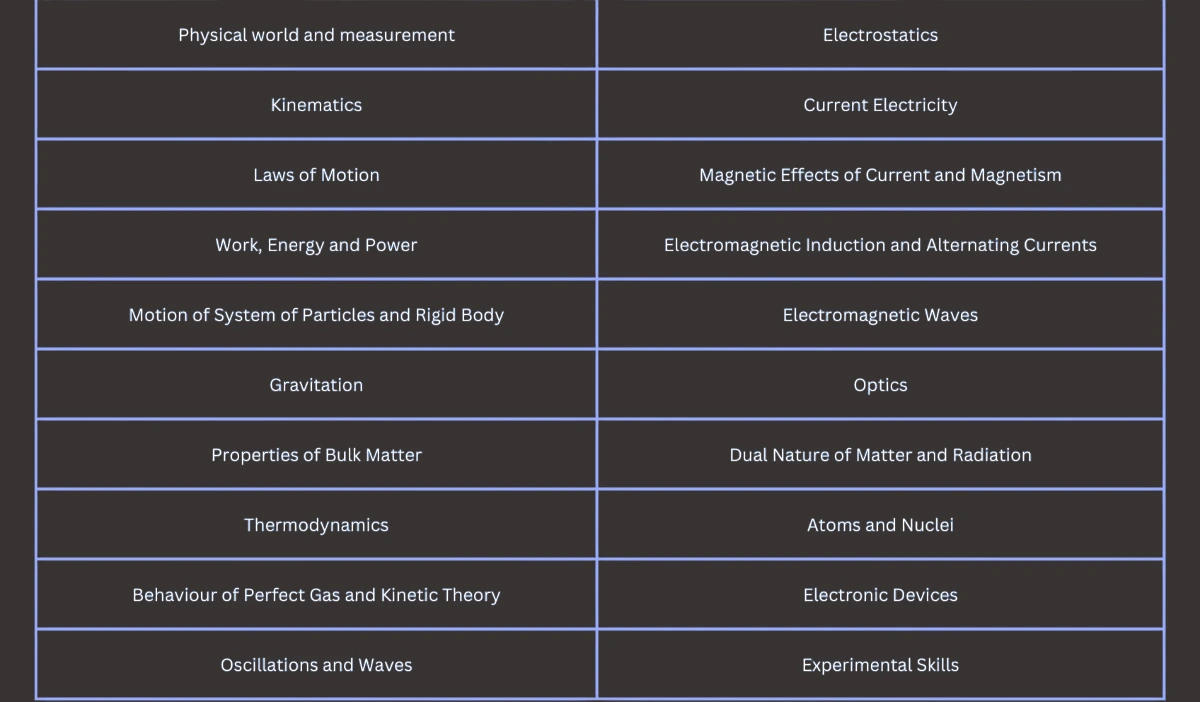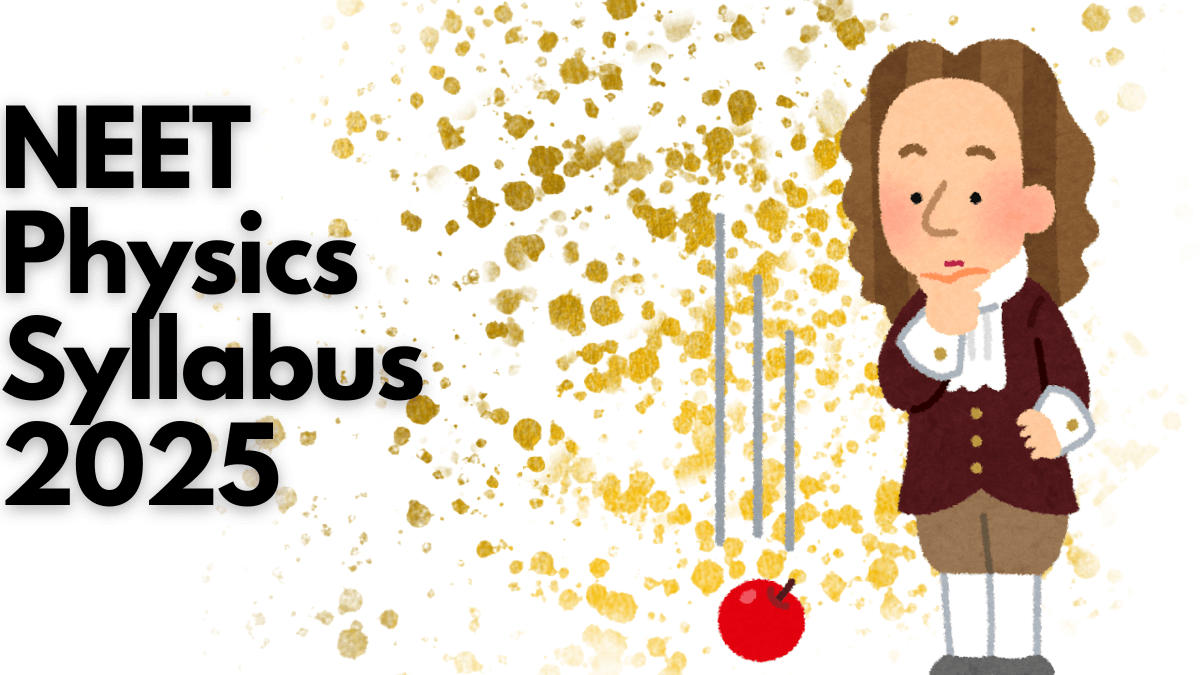Table of Contents
NEET Physics Syllabus 2025 PDF: Are you preparing for the NEET 2025 exam and hoping to get full marks in the Physics section? If you want to master the toughest section of NEET UG, you must first understand its syllabus. The National Testing Agency will hold the National Eligibility and Entrance Test for Undergraduates on May 4, 2025 (Sunday). The physics component accounts for 25% of the NEET Question Paper, totalling 180 out of 720 marks. To prepare for this portion, we must first thoroughly review the NEET Physics Syllabus 2025 and develop a study strategy based on it. The NEET Physics syllabus will lead you through this preparatory journey, telling you what to study and what not to study. The syllabus is an important component because it helps all applicants comprehend the various topics/subjects they must study for the exam.
NEET Physics Syllabus 2025
The sole method to guarantee top scores in the physics section of the NTA NEET UG 2025 is to possess a complete understanding of the NEET Physics syllabus 2025. Completing the complete NEET UG Physics Syllabus 2025 will help in efficient preparation and time management, making it easier to excel in this competitive examination. This article highlights the NEET Physics Syllabus 2025 PDF issued by NTA, which holds equal significance as other elements in the preparation process. We provide an extensive NEET Physics syllabus featuring key topics, chapter-wise weightage, and top-notch study resources.
NEET 2025 Physics Syllabus Overview
The NEET Physics Syllabus 2025 offers various topics necessary for understanding physical concepts and their applications. The syllabus is broken into two major parts: Class 11 and Class 12. Each section contains particular chapters that build on the fundamentals and progress to more advanced concepts. Understanding the NEET syllabus assists in developing a systematic study plan, focusing on essential areas, and avoiding irrelevant material.

What’s New in NEET Physics Syllabus 2025
To excel in NEET Physics, it’s crucial to establish a solid base. Rather than simply recalling formulas, concentrate on grasping the fundamental concepts to build a strong foundation. The NMC (National Medical Commission) has incorporated experimental-based subjects into the NEET Physics section, making up about 10% of the total topics. As per the revised exam pattern, the NTA NEET UG 2025 exam will consist of 45 compulsory questions.
NEET Physics Syllabus 2025 Class 11
The NEET Physics Syllabus 2025 for Class 11 covers foundational concepts such as the Physical World and Measurement, Kinematics, Laws of Motion, Work, Energy, and Power, Motion of a System of Particles and Rigid Body, Gravitation, Properties of Bulk Matter, Thermodynamics, Oscillations, and Waves. Check the detailed Physics syllabus for the NEET 2025 exam from class 11 below.
| Chapter Name | Topics |
|
Units and Measurements
|
Significant Figures, Errors in Measurement, Measuring Instruments
|
|
Mathematical Tools
|
Binomial Expression and Approximation, Functions & Graphs, Logarithms, Differentiation and Integration
|
|
Newton’s Laws of Motion
|
Newton’s First Law of Motion, Linear Momentum, Free Body Diagram, Working with Newton’s Second Law, Calculation of Acceleration, Frame of Reference, Rocket Propulsion, Types of Friction, Graph between Applied Force and Force of Friction, Angle of Friction and Angle of Repose, Acceleration of Body on Rough Surface, Dynamics of Circular Motion
|
|
Motion in a Straight Line
|
Frame of Reference, Motion under Gravity (Free Fall Motion), Graph of 1D Motion, Variable Acceleration
|
|
Motion in a Plane
|
Vector Addition, Resolution of Vectors, Vector Projection, Projectile Motion, Relative Motion, Circular Motion
|
| Gravitation |
Law of Gravitation, Acceleration due to Gravity, Gravitational Potential Energy, Gravitational Potential, Relation between Field and Potential, Escape Velocity, Satellite Motion, Kepler’s Laws of Planetary Motion, Weightlessness
|
|
Work, Energy & Power
|
Work, Work Energy Theorem, Conservative and Non-Conservative Force, Potential Energy, Equilibrium, Law of Conservation of Energy, Power, Vertical Circular Motion
|
|
Centre of Mass & System of Particles
|
Centre of Mass, Head-on Collision, Oblique Collision
|
|
Rotational Motion
|
Moment of Inertia, Theorems of Moment of Inertia, Radius of Gyration, Angular Momentum, Rolling Motion, Rolling Motion on Inclined Plane
|
|
Thermal Properties of Matter
|
Thermal Expansion, Application of Thermal Expansion, Specific Heat Capacity, Latent Heat, Calorimetry, Conduction, Radiation
|
|
Mechanical Properties of Solids
|
Hooke’s Law, Modulus of Elasticity, Young’s Modulus
|
|
Mechanical Properties of Fluids
|
Pressure, Buoyancy, Buoyant Force, Equation of Continuity, Bernoulli’s Theorem, Viscosity, Surface Tension
|
| Oscillations |
Periodic Motion and Oscillatory Motion, Some Basic Terms Related to Oscillatory Motion, Simple Harmonic Motion (SHM), Equations of SHM, Energy in SHM, Calculation of Time Period of Spring Block System, Time Period of Pendulum, Oscillation of Liquid Column
|
|
Kinetic Theory of Gases
|
Ideal Gases, Kinetic Theory of Gases, Different Speeds of Gas Molecules, Maxwell’s Law, Degree of Freedom, Law of Equipartition of Energy
|
|
Thermodynamics
|
Thermal Equilibrium and Zeroth Law, First Law of Thermodynamics, Different Types of Processes, Carnot Cycle and Carnot Engine, Heat Pump
|
| Waves |
Characteristics of Waves, Progressive Wave on String, Characteristics of Sound Wave, Principle of Superposition of Wave, Stationary Waves, Echo
|
NEET Physics Syllabus 2025 Class 12
The NEET Physics Syllabus 2025 for Class 12 covers advanced topics such as electrostatics, electromagnetic induction and alternating currents, current electricity, magnetic effects of current and magnetism, electromagnetic waves, optics, the dual nature of matter and radiation, atoms and nuclei, and electronic devices.
| Chapter Name | Details |
|---|---|
| Electric Charges and Fields | Charge, Coulomb’s Law, Electric Field of a Continuous Charge Distribution, Motion of a Charged Particle in Uniform Electric Field, Electric Field Lines, Electric Flux, Gauss Law, Application of Gauss’s Law, Electric Dipole, Dipole in a Uniform External Field, Short Dipole in Non-Uniform Electric Field |
| Electrostatic Potential and Capacitance | Electrostatic Potential/Potential Difference, Equipotential Surface, Electric Potential Due to Dipole, Electrostatics of Conductor |
| Current Electricity | Kirchhoff’s Laws and Combination of Resistances, Wheatstone Bridge and Symmetric Circuits, Electrical Measuring Instruments, RC Circuit |
| Moving Charges and Magnetism | Biot-Savart’s Law, Magnetic Field Due to a Current Carrying Ring and Problems on Combination of Ring and Rod, Ampere’s Law and Its Applications, Force on a Moving Charge in a Magnetic Field, Helical Path, Lorentz Force and Velocity Selector, Magnetic Force on a Current Carrying Conductor, Gyromagnetic Ratio, Torque on a Current Carrying Loop |
| Magnetism and Matter | Bar Magnet and Its Properties, Circular Coil as Magnetic Dipole, Tangent Galvanometer, Oscillation Magnetometer, Magnetisation and Magnetic Intensity, Classification of Magnetic Materials, Ferromagnetism and Hysteresis |
| Electromagnetic Induction | Magnetic Flux and Lenz’s Law, Calculation of Induced EMF, Induced Electric Field, Self Inductance, Mutual Inductance, LC Oscillations and Transformer, Faraday’s Law |
| Alternating Current | Introduction to Alternating Current, Average and RMS Values, Types of AC Circuits, Power & Power Factor, Choke Coil, Series LCR Circuit and Resonant Frequency, LC Oscillations and Transformer |
| Electromagnetic Waves | Characteristics of Electromagnetic Waves |
| Ray Optics and Optical Instruments | Reflection from Plane Mirror, Reflection from Spherical Mirror, Refraction from Plane Surface, Total Internal Refraction, Newton’s Formula, Combination of Lens and Mirror, Displacement Method to Find Focal Length, Dispersion of Light, Optical Instruments |
| Wave Optics | Nature of Light, Interference of Light, Diffraction of Light, Polarisation |
| Dual Nature of Radiation and Matter | Quantum Theory of Light, Photoelectric Effect |
| Atoms | Bohr’s Model |
| Nuclei | Mass Energy, Nuclear Size, Nuclear Stability, Binding Energy, Nuclear Energy |
| Semiconductor Electronics: Materials, Devices and Simple Circuits | PN Junction Diode, Application of PN Junction Diode, Logic Gate |
NTA NEET 2025 Physics Syllabus PDF Download
To fully prepare, students need to obtain the NEET Physics Syllabus 2025 PDF from the NTA website. This booklet describes all of the Physics themes and subtopics, ensuring that students understand every important concept.
Check NEET UG syllabus for more subjects below:
| Domain | Syllabus | Previous Year Question |
| Biology | NEET Biology syllabus | NEET Biology Previous Year Question Paper |
| Chemistry | NEET Chemistry syllabus | NEET Chemistry Previous Year Question Paper |
Topics Removed From NEET 2025 Syllabus
The National Testing Agency (NTA) has published the NEET Physics syllabus for 2025, featuring several new updates and changes. Review the deleted Physics syllabus for NEET below.
|
Units Name
|
Deleted Topics
|
|
Physics and Measurement
|
Scope and excitement of Physics, Nature of physical laws, Need for measurement
|
|
Kinematics
|
Elementary concepts of differentiation and integration for describing motion
|
|
Laws of Motion
|
Equilibrium of concurrent forces, Lubrication
|
|
Rotational Motion
|
Momentum conservation, Centre of mass of uniform rod
|
|
Gravitation
|
Geostationary satellites
|
|
Properties of Solids and Liquids
|
Shear, modulus of rigidity, Poisson’s ratio, Elastic energy, Reynold’s number
|
|
Thermodynamics
|
Qualitative ideas of Black Body Radiation, Wein’s displacement law, Greenhouse effect, Cp, Cv, Newton’s law of cooling, Stefan’s law
|
|
Oscillations and Waves
|
Free, forced, and damped oscillations (qualitative ideas only), Resonance, Doppler effect
|
|
Electrostatics
|
Free charges and bound charges inside a conductor, Van de Graaff generator
|
|
Current Electricity
|
Flow of electric charges in a metallic conductor, Carbon resistors, color code for resistors
|
|
Magnetic Effects of Current and Magnetism
|
Magnetic dipole moment of a revolving electron, Earth’s magnetic field
|
|
Electromagnetic Induction
|
Concept of magnetic field, Oersted’s experiment, Cyclotron
|
|
Alternating Currents
|
LC oscillations (qualitative treatment only)
|
|
Optics
|
Reflection and refraction of plane wave, Scattering of light
|
|
Dual Nature of Matter and Radiation
|
Davisson-Germer experiment (experimental details omitted)
|
|
Atoms and Nuclei
|
Isotopes, isobars, isotones, radioactivity (alpha, beta, gamma particles), decay law
|
|
Electronic Devices
|
Energy bands in solids, conductors, insulators, Transistor action, amplifier (common emitter configuration), transistor as a switch
|
NEET Physics Syllabus 2025 Weightage
A well-rounded NEET preparation strategy requires a combination of 11th and 12th Class studies. So Students must know the weightage of all chapters in the exam and how many questions will be asked. Check the chapter wise exam weightage from the table.
| NEET Chapter Wise Weightage for Physics | ||
|
Physics Chapters/Topics
|
Weightage (%) |
Average No. of Questions
|
|
Mechanical Properties of Solids
|
2% | 1 |
|
Moving Charges and Magnetism
|
5% | 2 |
|
Center of Mass & System of Particles
|
2% | 1 |
| Wave Optics | 2% | 1 |
|
Electromagnetic Induction
|
3% | 1 |
|
Mechanical Properties of Fluids
|
3% | 2 |
|
Electromagnetic Waves
|
3% | 2 |
|
Rotational Motion
|
6% | 3 |
| Oscillations | 3% | 1 |
|
Ray Optics and Optical Instruments
|
6% | 3 |
|
Kinetic Theory of Gases
|
3% | 1 |
|
Dual Nature of Radiation and Matter
|
3% | 2 |
| Gravitation | 3% | 2 |
|
Current Electricity
|
10% | 5 |
|
Semiconductor Electronics: Materials, Devices and Simple Circuits
|
5% | 3 |
|
Units and Measurements
|
5% | 3 |
|
Work Energy and Power
|
3% | 2 |
|
Electric Charges and Fields
|
3% | 2 |
|
Magnetism and Matter
|
1% | 1 |
| Atoms | 3% | 1 |
| Nuclei | 4% | 2 |
|
Motion in a Plane
|
3% | 1 |
|
Mathematical Tools & Vectors
|
1% | 1 |
| Laws of Motion | 2% | 1 |
|
Thermodynamics
|
2% | 1 |
| Waves | 1% | 1 |
|
Electrostatic Potential and Capacitance
|
5% | 3 |
|
Alternating Current
|
4% | 2 |
|
Thermal Properties of Matter
|
1% | 0 |
NEET UG 2025 Physics Important Topics
Candidates can check the important topics for the NEET Physics syllabus for this year’s exam below.
| Name of the Chapter | Important Topics |
| Units and Measurements |
|
| Mathematical Tools |
|
| Motion in a Straight Line |
|
| Motion in a Plane |
|
| Newton’s Laws of Motion |
|
| Work, Power, and Energy |
|
| Centre of Mass & System of Particles |
|
| Rotational motion |
|
| Gravitation |
|
| Mechanical Properties of Solids |
|
| Thermal Properties of Matter |
|
| Kinetic Theory of Gases |
|
| Thermodynamics |
|
| Oscillations |
|
| Waves |
|
| Electric Charges and Fields |
|
| Electrostatic Potential and Capacitance |
|
| Current Electricity |
|
| Moving Charges and Magnetism |
|
| Magnetism and Matter |
|
| Electromagnetic Induction |
|
| Alternating Current |
|
| Electromagnetic Waves |
|
| Ray Optics and Optical Instruments |
|
| Wave Optics |
|
| Dual Nature of Radiation and Matter |
|
| Atoms |
|
| Nuclei |
|
| Semiconductor Electronics: Materials, Devices and Simple Circuits |
|
NEET Physics Most Important Questions
NEET UG Physics Paper Pattern 2025
The NTA has recently revised the NEET UG 2025 Physics paper pattern. Now the physics section will no longer be divided into Part A and Part B, there will be only one section. The physics section will contain 45 compulsory questions.
| Section | Total no. of questions | Questions to be attempted | Marks per question | Maximum Marks |
| Physics | 45 | 45 | +4 for every correct answer, -1 for every incorrect response | 180 |
Best Books for NEET Physics Syllabus Preparation
Candidates can check the best books for the preparation of NEET UG 2025 syllabus below.
- Fundamental Physics by Pradeep
- Fundamentals of Physics by Halliday, Resnick, and Walker
- Concepts of Physics by H C Verma
- NCERT Physics by Anil Aggarwal
- Objective Physics By DC Pandey
- Physics for NEET by C P Singh
- Problems in General Physics by I E Irodov
How to Prepare NEET Physics Syllabus
Having understood the NEET Physics syllabus and its chapter-wise weightage, it is essential to formulate an effective preparation strategy. Here are a few crucial tips to assist you in mastering the Physics section:
Make Your concepts Strong: Physics centers on concepts, making a solid foundation essential. If you encounter any chapter or topic difficult after examining the syllabus, go back to the fundamentals- even if you have studied it previously. Utilize school textbooks, seek advice from teachers, mentors, or older students, and ensure all uncertainties are fully clarified.
Concentrate on Important Topics: Determine chapters that carry more weight and give them priority. Make sure you fully grasp these essential subjects and work on many practice problems. Regularly assess your performance, and if you receive a low score, pinpoint the deficiencies and modify your study plan as needed.
Develop a Successful Preparation Plan: Your plan should concentrate on two main aspects:
- Time Management: Create a schedule that provides adequate time for every subject and topic. Incorporate specific times for preparation, review, and practice.
- Subject-Based Strategy: Start with simpler subjects and progressively tackle more difficult ones. Focus on your strengths and weaknesses, tackling one topic at a time.
Frequent Practice and Review: Merely finishing chapters is insufficient; ongoing practice and review are crucial. Create brief revision notes upon completing each topic and revisit them consistently. Engage in diverse questions and complete sectional mock examinations to assess your development and enhance your abilities.
Utilize Resources and Ask for Help: Maintain communication with your instructors, classmates, and advisors for assistance when you encounter difficulties. Furthermore, make use of the extensive online resources for NEET Physics study, such as practice tools and video lectures.
By adhering to these suggestions, maintaining discipline, and practicing regularly, you can excel in the us and enhance your overall performance.
In conclusion, Preparation in line with the well-structured NEET Physics syllabus is an invaluable resource that increases the chances to get selected. By adhering to the syllabus, students can ensure that all topics are covered. It aids in prioritizing vital concepts, allocating time efficiently, and focusing on areas that require additional attention.




 NEET UG 2025: Is NEET Previous years Que...
NEET UG 2025: Is NEET Previous years Que...
 NEET Botany Syllabus 2025 Out, Check Cha...
NEET Botany Syllabus 2025 Out, Check Cha...
 NEET Cut Off: NEET 2025 Safe Score By Ca...
NEET Cut Off: NEET 2025 Safe Score By Ca...


